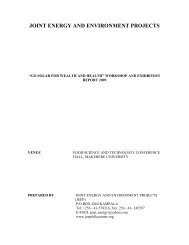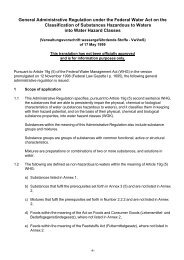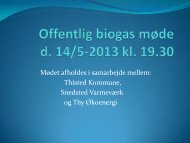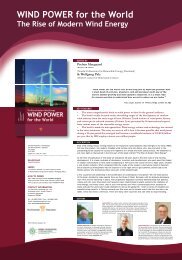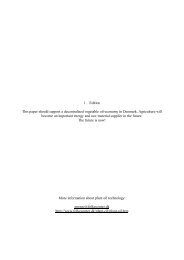You also want an ePaper? Increase the reach of your titles
YUMPU automatically turns print PDFs into web optimized ePapers that Google loves.
Carbon/nitrogen (C/N) ratio<br />
Just like any other organism, methanogens<br />
need a number of macro- and micronutrients<br />
in order to grow (see figure 11). The most important<br />
macronutrients are nitrogen (N), phosphorus<br />
(P) and potassium (K). Nitrogen is used<br />
by bacteria to produce proteins. The nitrogen<br />
content is often quoted in relation to carbon,<br />
as this gives an indication of whether there is<br />
sufficient nitrogen available for bacteria. Normally<br />
the C/N ratio should be less than 30/1,<br />
as nitrogen otherwise becomes the limiting<br />
factor for bacterial growth. On the other hand,<br />
the nitrogen level should not be too high as<br />
this can then also inhibit the process.<br />
Essential Optimum concentration<br />
micronutrients g/m 3<br />
Barium (Ba) 0.05<br />
Iron (Fe) 0.2<br />
Calcium (Ca) 0.03<br />
Cobalt (Co) 0.005<br />
Magnesium (Mg) 0.02<br />
Molybdenum (Mo) 0.005<br />
Nickel (Ni) 0.01<br />
Figure 11. Essential micronutrients in the biogas process<br />
and approximate optimum concentration. As with vitamins<br />
for humans, both too little and too much can be a<br />
bad thing.<br />
Stirring<br />
There are a number of different plant types,<br />
but for the most common type – CSTR (Continuously<br />
Stirred Tank Reactors) – the biomass<br />
has to be vigorously agitated to avoid the formation<br />
of an impenetrable surface crust.<br />
COD = Chemical Oxygen Demand. The amount<br />
of oxygen used to degrade organic matter in water.<br />
COD is an expression for how much oxygen<br />
is needed to degrade organic matter to CO 2 and<br />
H 2 O. It is mostly used to measure the organic<br />
loading of an aquatic environment. It is usually<br />
given in mg O 2 /litre water. In biogas plants, the<br />
COD is given in kg/m 3 = 1000 mg/L.<br />
12<br />
Organic load<br />
The rate at which biomass is added to the reactor<br />
has to be adjusted to the growth rate of the<br />
methanogens and organic acids have to be removed<br />
at the rate at which they are produced.<br />
The normal load for a CSTR reactor is 1-6 kg<br />
COD/m 3 reactor volume/day.<br />
If more biomass is added than the bacteria<br />
are able to degrade, the process will become<br />
acidic. The biomass also has to be fed to the<br />
reactor at an even rate and volume, preferably<br />
as a continuous feed. If the substrate has to be<br />
changed, this must be done gradually, so that<br />
bacteria can adapt to the new conditions.<br />
inHibition of tHe biogas<br />
Process<br />
Inhibition means that a substance has a negative<br />
effect on bacteria without directly killing<br />
them. The process can be inhibited in many<br />
ways and the ways are often divided into endogenous<br />
and exogenous causes. Endogenous<br />
inhibition is due to conditions or material<br />
created during the process itself that under<br />
certain circumstances may inhibit the process,<br />
and exogenous inhibition is due to external<br />
conditions.<br />
Nitrogen inhibition<br />
One of the most significant endogenous inhibitors<br />
is ammonia (NH ). Ammonia is created du-<br />
3<br />
ring the bacterial degradation of nitrogen-containing<br />
substances such as proteins. Nitrogen is<br />
essential for bacterial growth and ammonia is<br />
an important source of nitrogen. But ammonia<br />
at high concentrations is highly toxic to the<br />
bacteria.<br />
In an aqueous solution ammonia is always<br />
found in an equilibrium with ammonium<br />
+ (NH ). This equilibrium is determined by the<br />
4<br />
acidity, pH and temperature of the environment<br />
and, as ammonium is not as toxic as ammonia,<br />
this equilibrium is important:<br />
+ NH NH3 + H 4<br />
+





